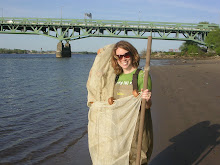 Last Friday the Marine Mammal Stranding Center came to Sandy Hook with two stranded harp seals. They called our office in hope of recruiting volunteers to help with the release. There are two environmental organizations (American Littoral Society and Clean Ocean Action) in our building so MMSC had no problem convincing a few of us to leave our desks and help them with the seals. In fact, MMSC likely releases the seals at Sandy Hook because of the easy access to volunteers. One phone call to our building and they get at least five people willing to help out.
Last Friday the Marine Mammal Stranding Center came to Sandy Hook with two stranded harp seals. They called our office in hope of recruiting volunteers to help with the release. There are two environmental organizations (American Littoral Society and Clean Ocean Action) in our building so MMSC had no problem convincing a few of us to leave our desks and help them with the seals. In fact, MMSC likely releases the seals at Sandy Hook because of the easy access to volunteers. One phone call to our building and they get at least five people willing to help out.  There have been about ten seals released in the past couple of months, most of them harp seals. The strange thing about this is that NJ is really far out of this seal’s range. In fact, the US in general is out the harp seal’s range. Harp seals are highly migratory, but tend not to come south of Canada. Scientists are unsure why the seals are coming so far south, but some speculate that they could be following a food source down. One consequence of the seals coming further south is that there have been a lot of strandings. You might recall the seal that was found by a snow plow driver in Woodbridge last year during a snow storm. That was a harp seal. There have also been reports of harp seals showing up on golf courses and in parking lots. Harp seals spend most of their winters up on ice packs.
There have been about ten seals released in the past couple of months, most of them harp seals. The strange thing about this is that NJ is really far out of this seal’s range. In fact, the US in general is out the harp seal’s range. Harp seals are highly migratory, but tend not to come south of Canada. Scientists are unsure why the seals are coming so far south, but some speculate that they could be following a food source down. One consequence of the seals coming further south is that there have been a lot of strandings. You might recall the seal that was found by a snow plow driver in Woodbridge last year during a snow storm. That was a harp seal. There have also been reports of harp seals showing up on golf courses and in parking lots. Harp seals spend most of their winters up on ice packs.  There doesn’t tend to be floating ice off the coast of NJ so this could be why the seals are coming up onto land. Seals rely on the ice as a source of fresh water and to escape the cold winter waters. Unfortunately when the harp seals come up onto land they can get stuck there. Enter Marine Mammal Stranding Center along with a handful of excited volunteers from building 18!
There doesn’t tend to be floating ice off the coast of NJ so this could be why the seals are coming up onto land. Seals rely on the ice as a source of fresh water and to escape the cold winter waters. Unfortunately when the harp seals come up onto land they can get stuck there. Enter Marine Mammal Stranding Center along with a handful of excited volunteers from building 18! 
Harp seals can weigh 400 lb and measure 6 ft in length so it took a lot of muscle to carry the cage from the truck down to the water’s edge. The first seal we released, a large female, quickly made her way to the ocean. The second seal, which was a lot smaller, was hesitant to leave the cage. He would make his a way a few feet towards the ocean and then stop. It took a bit of pushing from the brave volunteers at MMSC (harp seals can leave a nasty bite if they want to), but eventually they got him to enter the water. He is equipped with a tracking device so that they can monitor his movement and make sure he doesn’t get stranded again. Check out mmsc.org for information on strandings and rescues. 






